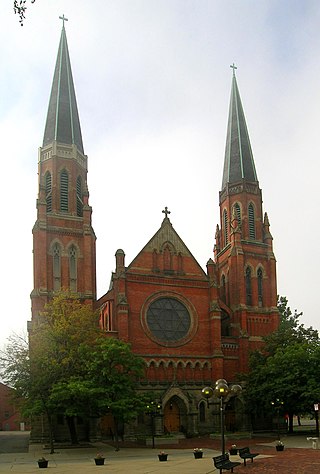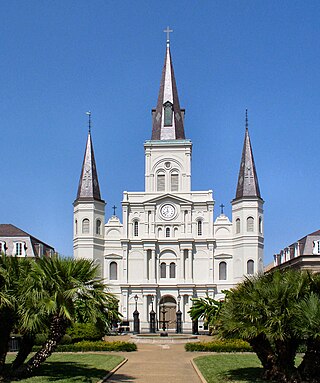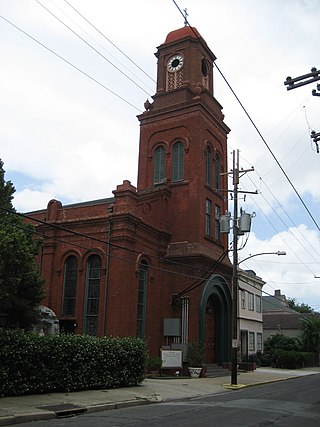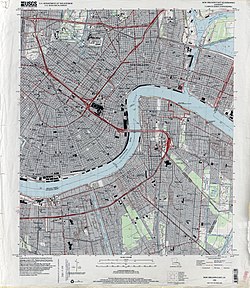
The French Quarter, also known as the Vieux Carré, is the oldest neighborhood in the city of New Orleans. After New Orleans was founded in 1718 by Jean-Baptiste Le Moyne de Bienville, the city developed around the Vieux Carré, a central square. The district is more commonly called the French Quarter today, or simply "The Quarter", related to changes in the city with American immigration after the 1803 Louisiana Purchase. Most of the extant historic buildings were constructed either in the late 18th century, during the city's period of Spanish rule, or were built during the first half of the 19th century, after U.S. purchase and statehood.

Saint Louis Cemetery is the name of three Catholic cemeteries in New Orleans, Louisiana. Most of the graves are above-ground vaults constructed in the 18th and 19th centuries.

Tremé is a neighborhood in New Orleans, Louisiana. "Tremé" is often rendered as Treme, and the neighborhood is sometimes called by its more formal French name, the Faubourg Tremé; it is listed in the New Orleans City Planning Districts as Tremé / Lafitte when including the Lafitte Projects.

Basilica of Sainte Anne de Détroit (Sainte-Anne-de-Détroit) was founded July 26, 1701 by French colonists in New France, and is the second-oldest continuously operating Roman Catholic parish in the United States. The current Gothic Revival cathedral-styled church, built in 1886, is located at 1000 St. Anne Street in Detroit, Michigan, in the Hubbard-Richard neighborhood, near the Ambassador Bridge, and the Michigan Central Station. At one time it was the seat of a diocese that included French territory in Ontario, Canada south of the Detroit River.

The Central Business District (CBD) is a neighborhood of the city of New Orleans, Louisiana, United States.

Bywater is a neighborhood of the city of New Orleans. A subdistrict of the Bywater District Area, its boundaries as defined by the City Planning Commission are: Florida Avenue to the north, the Industrial Canal to the east, the Mississippi River to the south, and the railroad tracks along Homer Plessy Way to the west. Bywater is part of the Ninth Ward of New Orleans. It includes part or all of Bywater Historic District, which is listed on the National Register of Historic Places.

The Cathedral-Basilica of Saint Louis, King of France, also called St. Louis Cathedral, is the seat of the Roman Catholic Archdiocese of New Orleans and is the oldest cathedral in continuous use in the United States alongside the Royal Presidio Chapel in Monterey, California. It is dedicated to Saint Louis, also known as King Louis IX of France. The first church on the site was built in 1718; the third, under the Spanish rule, built in 1789, was raised to cathedral rank in 1793. The second St. Louis Cathedral was burned during the great fire of 1788 and was expanded and largely rebuilt and completed in the 1850s, with little of the 1789 structure remaining.

The Archdiocese of New Orleans is a Latin Church ecclesiastical division of the Catholic Church spanning Jefferson, Orleans, Plaquemines, St. Bernard, St. Charles, St. John the Baptist, St. Tammany, and Washington civil parishes of southeastern Louisiana. It is the second to the Archdiocese of Baltimore in age among the present dioceses in the United States, having been elevated to the rank of diocese on April 25, 1793, during Spanish colonial rule.

Uptown is a section of New Orleans, Louisiana, United States, on the east bank of the Mississippi River, encompassing a number of neighborhoods between the French Quarter and the Jefferson Parish line. It remains an area of mixed residential and small commercial properties, with a wealth of 19th-century architecture. It includes part or all of Uptown New Orleans Historic District, which is listed on the National Register of Historic Places.

Irish Channel is a neighborhood of the city of New Orleans. It is a subdistrict of the Central City/Garden District Area. Although the original site was located predominantly on the east side of Jackson Avenue, its boundaries as defined by the Historic District Landmarks Commission are: Magazine Street to the north, Jackson Avenue to the east, the Mississippi River to the south and Delachaise Street to the west.
Joseph Francis Rummel was a German-born American Catholic prelate of the Roman Catholic Church. He served as bishop of the Diocese of Omaha in Nebraska from 1928 to 1935 and as archbishop of the Archdiocese of New Orleans from 1935 to 1964.

James Gallier was a prominent nineteenth-century Irish-born American architect, most famed for his buildings in New Orleans. Gallier Hall, which he designed and once served as New Orleans City Hall, is named after him.

The Presbytère is an architecturally important building in the French Quarter of New Orleans, Louisiana. It stands facing Jackson Square, adjacent to the St. Louis Cathedral. Built in 1813 as a matching structure for the Cabildo, which flanks the cathedral on the other side, it is one of the nation's best examples of formal colonial Spanish architecture. It was designated a National Historic Landmark in 1970, and is now a property of the Louisiana State Museum.

St. Frances Cabrini Church was a Roman Catholic parish church in New Orleans, Louisiana, from 1963 until 2005, when it was extensively damaged by floodwaters of Hurricane Katrina. The church was designed in the modernist style by New Orleans architectural firm Curtis and Davis. Their design was intended to facilitate parishioners' participation in religious ceremonies. The church building did not re-open after Hurricane Katrina and was demolished in 2007 amid controversy over architectural preservation.

The buildings and architecture of New Orleans reflect its history and multicultural heritage, from Creole cottages to historic mansions on St. Charles Avenue, from the balconies of the French Quarter to an Egyptian Revival U.S. Customs building and a rare example of a Moorish revival church.

St. Augustine Church is a Catholic parish in New Orleans. Established by free people of color, who also bought pews for slaves, it is said to be the oldest Black Catholic parish in the United States, established in 1841. It was one of the first 26 sites designated on the state's Louisiana African American Heritage Trail.

Blessed Francis Xavier Seelos Catholic Church, formerly St. Vincent de Paul Church, is a church in New Orleans listed on the National Register of Historic Places. The parish was founded in 1838 as the third parish in the city. The original parish boundaries intersected those of St. Louis Cathedral, New Orleans and served the French community. In fact, the French tradition was so strong that sermons were not given in English until the 1880s. In later years, its parish boundaries overlapped the boundaries of Holy Trinity Church, which served German residents.
The Faubourg Livaudais is a name of a neighborhood in central New Orleans that some people have re-adopted based upon the name of a former plantation that was in the area. The neighborhood is largely residential and contains mostly modest sized homes.

Marigny Opera House, also known as the Church of the Arts, is an opera house and performing arts center in Faubourg Marigny, New Orleans, Louisiana. The Marigny was originally a Catholic parish church known as Holy Trinity Catholic Church. It was closed by the Archdiocese of New Orleans in 1997.

The Basilica of St. Stephen is a church in New Orleans, Louisiana, United States, that became a minor basilica in June 2022. It is also known as Saint Stephen Church. It is located in Uptown New Orleans. The Basilica of St. Stephen is part of Good Shepherd Parish and has a parochial school associated with it.

























